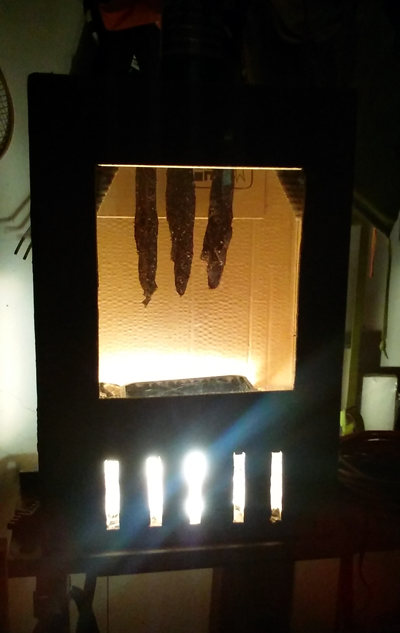Biltong Maker From Stuff in the Garage
by Mage and the machine in Cooking > Canning & Preserving
4092 Views, 16 Favorites, 0 Comments
Biltong Maker From Stuff in the Garage

I wanted to make biltong (the South African dried meat, similar to American jerky) but didn't have the equipment. Someone I know has one that was given to him, and he said "Why not make your own?", so I did. It makes very good biltong using only the heat from a 100W incandescent light bulb.
Not wanting to spend real money on it, I used what I had in the garage. Luckily I had the ideal sized strong, cardboard box. I won a suitcase in the lottery; I'd have preferred the jackpot but then I wouldn't have had the ideal box!
My box does not get very warm and has not come anywhere close to catching fire, but I don't take any responsibility for any mishap anyone may have after following this instructible. Be cautious when making it and ensure that the light bulb does not sit too close to any combustible material.
The Biltong Maker in Action



My box does not get very warm and has not caught fire, but I don't take any responsibility for any mishap anyone may have after following this instructible. Be cautious when making it and ensure that the light bulb does not sit too close to any combustible material.
What you'll need:
- Cardboard box, ideally thick, corrugated, about 60cm high, 40cm wide, 23cm deep
- More cardboard or thin wood for the structure inside
- A simple light bulb fitting with bulb, cable and plug
- Dowels to hang the meat on
- Some gauze
- Aluminium foil
- Some screws, scrap wood strips
- Basic tools
- Glue
- Some basic ingenuity to figure out my instructions and make it work for you, after all I don't know what you have in your garage / workshop
The Light & the Shelf



Make a shelf to sit about 17cm above the floor of the box. The light fitting sits below this shelf. Ensure you leave some flaps on the ends to fit it to the sides of the box, or make the flaps 17cm long and fold them down so the shelf rests on these 'legs'. The shelf I made has a drip tray in the middle, directly under the meat (it will drip) and slots at the ends so the heat can rise through the meat. The drip tray is a disposable container that I bought meat in.
Make a holder for the light fitting so it fits horizontally under the shelf. I made an L shaped bracket, with a strut to keep the L at 90º.
Cut holes / slots in the sides of the box at the hieght of the light bulb, so that air can be drawn in by convection. Cover these holes with gauze, in case insects like biltong too. I found some left-over tulle that a family member had used for dressmaking (not in the garage, but still...)
Cut a hole in the bottom for the cable to the light fitting. Fit the light fitting, bulb and cable; optionally adding aluminium foil to keep the light / heat in the box, without covering the air holes. Then fit the shelf above the light.
The Window & the Rails


At this point I cut a front 'window' which is useful to see what's happening inside although not necessary. I happened to have some thin acrylic sheet from a very cheap artwork frame, so used that to create the window 'glass'.
Now fit a cardboard or wooden rail on each side of the top of the box, with slots so that the dowels for hanging the meat can stay evenly spaced, above the drip tray. Cut the dowels to fit in the box on these rails.
Cut holes / slots in the top of the box, also covering with gauze. Switch it on and check that it doesn't get too warm.
Making Biltong
Now prepare your meat. By the way, there are much better descriptions on making biltong elsewhere, but if you don't want to go looking, here are my basic steps.
Use good quality meat, but not the best. Cut the meat into long, thinnish strips, remembering that it will shrink considerably. Make a marinade of vinegar and spices – the correct spices give biltong the real South African taste – and marinade in the fridge for 24 hours, turning regulary. There are commercially available spices, e.g. Safari brand, but there are also spice mix recipes available on the internet. Hang the strips of meat on hooks (I used paperclips, they seemed to be OK for a few uses) and dry for roughly 48-72 hours. Roughly 48 hours should give a soft biltong with a reddish centre, 72 hours will be drier all the way through. Biltong freezes very well! Just give it a bit of time to defrost.
Enjoy!